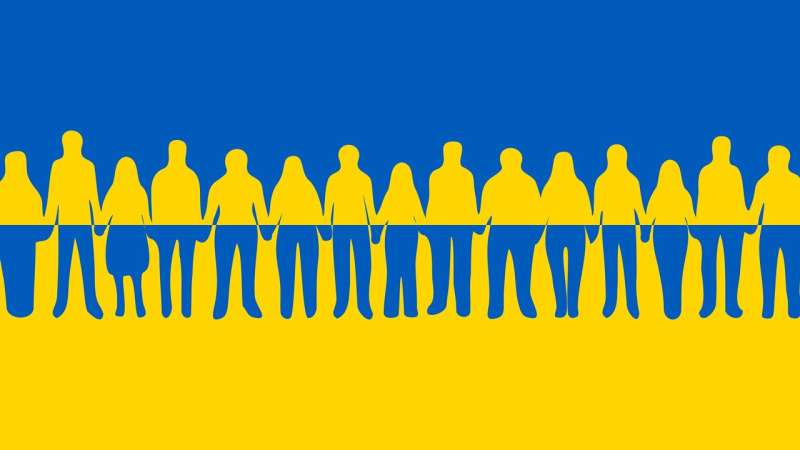This article has been reviewed according to Science X's editorial process and policies. Editors have highlighted the following attributes while ensuring the content's credibility:
fact-checked
trusted source
written by researcher(s)
proofread
How Ukraine's savvy official social media rallied the world and raised the bar for national propaganda

Just days after the Russian military launched a full-scale invasion of Ukraine in February 2022, stories of Ukrainian resistance were already circulating with a ferocity all their own.
Part of this was due to the Ukrainian government's savvy use of social media.
On March 7, 2022, for example, the government posted a video on Twitter, the platform now known as X, showing clips of Ukrainian farmers using John Deere tractors to tow away disabled Russian tanks and equipment. The image came with a simple message, complemented by a tractor icon: "Don't mess with Ukrainian farmers."
This video caught my attention—and that of my colleague Andrew Pyle, who, like me, studies the strategic use of communication.
We decided to study all of the posts that the Ukrainian government and the city of Kyiv posted to their official Twitter accounts during the first days of the Russian invasion. We found that the governments strategically used the platform as a form of crisis communication and public diplomacy.
While Ukraine was battling the Russian army on its land, it was also fighting for the hearts and minds of people following the conflict on social media from afar.
The process
We analyzed 163 tweets posted by the verified @Ukraine government and @Kyiv government accounts from Feb. 1, 2022, until May 1, 2022. We found many examples of Ukraine and Kyiv using the theme of resilience to boost their own image on the platform. Both of the accounts posted almost exclusively about the war during this period, with posts ranging from fundraising campaigns to appeals for users to "tag @Russia and tell them what you think about them."
Kyiv's account, which has 2.1 million followers and describes itself as "the city of courage" on its page, posted an image on March 9, 2022, that depicted a woman breastfeeding an infant against the backdrop of a map of the city's subway system. The imagery here closely resembles Catholic iconography of the Virgin Mary with baby Jesus.
Ukraine's account has 2.3 million followers and the playful description, "Yes, this is the official twitter account of Ukraine." It posted a similarly religious-themed post about the war on Christmas Eve in 2022.
Digital public diplomacy
Other tweets over the past two years seem directed at strengthening relationships with the United States and other countries that have helped Ukraine defend itself against Russia.
One tweet from Ukraine's official account in 2022 thanked the U.S. for its support by wishing its "American friends" a happy Fourth of July. It posted another similar message directed at Americans in 2023, presenting Ukraine as a freedom-and-independence-loving country.
In this way, Ukraine's social media approach closely reflects what some scholars have called "selfie diplomacy"—or how a country uses social media to "draw its own self-portrait."
While scholars have begun to examine the role of social media for public diplomacy, relatively little is known about how countries can use X and other social media platforms to influence how people see them during a time of conflict.
But the broader use of technology to manipulate public opinion about war is far from new.
A strong historical precedent
The Woodrow Wilson administration, for example, enlisted the theorist Edwards Bernays, who is often referred to as the "father of public relations," to help its war effort during the 1910s.
Bernays worked with the newly authorized Committee on Public Information, a government agency tasked with building public support for World War I at home. Experts have also noted that this committee was essentially a government propaganda office, which at times engaged in disinformation.
Within months, Bernays and the committee helped shift public support for a war Americans had initially been reluctant to join by promoting the idea that the U.S. was involved in the fighting to bring democracy to Europe.
In particular, Bernays directed the CPI's Latin News Service in order to build support for the war among Latin American allies. He enlisted American companies doing business overseas to distribute literature about America's reasons for entering the war.
Bernays, a nephew of Sigmund Freud, knew that the use of symbols and images could sell the idea of war to the public. As Bernays wrote in 1942, "Arms and armaments are not the only weapons … ideas are weapons too."
These same principles apply in the case of the Ukraine war today.
Connecting with people
Ukraine has been trying to join NATO ever since the country gained independence from the Soviet Union in 1991.
Throughout the conflict, Ukraine has made numerous appeals on X to its allies in Europe and North America to accept its application to join the alliance.
It has also relied heavily on interactions with Western social media and culture to connect with people in foreign countries in creative ways.
For instance on Feb. 25, 2022, the Twitter account for the widely popular American television series "The Simpsons" posted an image of the namesake family stoically holding Ukrainian flags. A few hours later, Ukraine replied to the tweet with blue and yellow heart emojis along with a GIF from a "Simpsons" episode.
While our study does not contain data beyond May 2022, Ukraine and Kyiv's X accounts have continued to publish content that reflects these general themes of national resilience and diplomacy.
As the war in Ukraine continues, the government's strategic use of social media could serve as a model, or at least a point of consideration, to other countries also trying to advance their public images—especially during war and other times of hardship.
Provided by The Conversation
This article is republished from The Conversation under a Creative Commons license. Read the original article.![]()




















